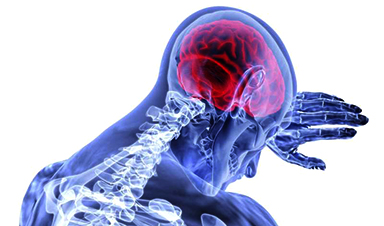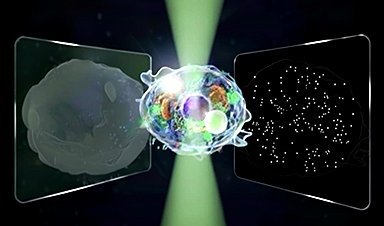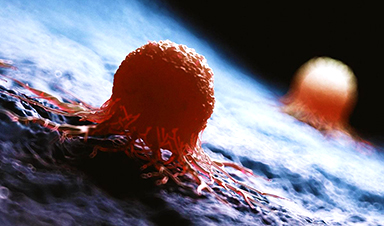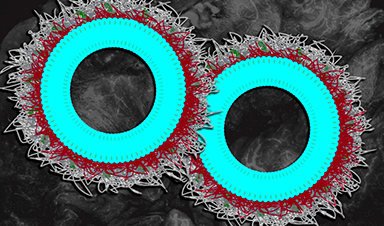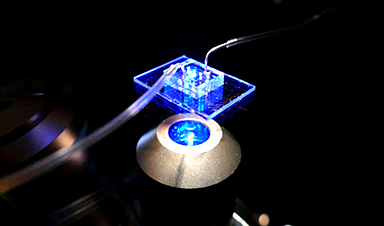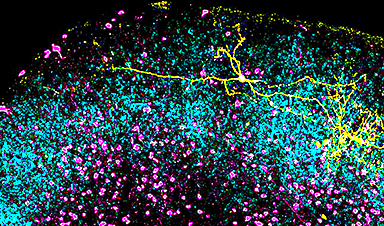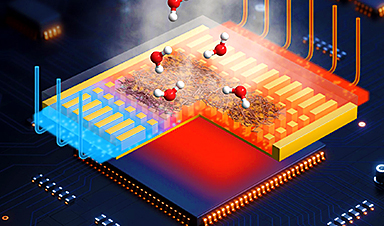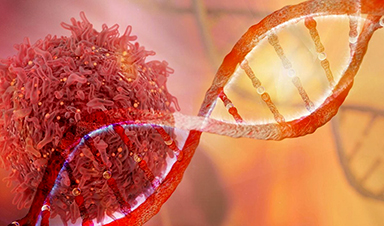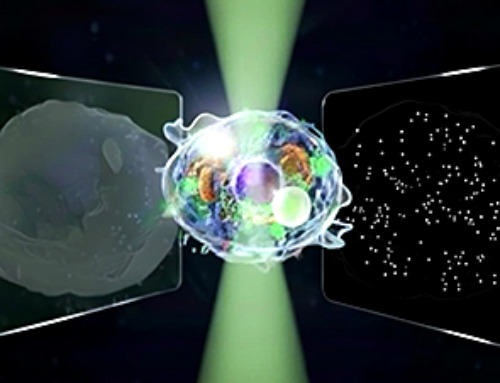A collaborative team from Penn Medicine and Penn Engineering has uncovered the mathematical principles behind a 500-million-year-old protein network that determines whether foreign materials are recognized as friend or foe.
How does your body tell the difference between friendly visitors, like medications and medical devices, and harmful invaders such as viruses and other infectious agents? According to Jacob Brenner, a physician-scientist at the University of Pennsylvania, the answer lies in a protein network that dates back over 500 million years, long before humans and sea urchins evolved along separate paths.
"The complement system is perhaps the oldest-known part of our extracellular immune system," says Brenner. "It plays a crucial role in identifying foreign materials like microbes, medical devices, or new drugs—particularly the larger ones like in the COVID vaccine."
The complement system can act as both protector and aggressor, offering defense on one side while harming the body on the other. In some cases, this ancient network worsens conditions like stroke by mistakenly targeting the body's own tissues. As Brenner explains, when blood vessels leak, complement proteins can reach brain tissue, prompting the immune system to attack healthy cells and leading to worse outcomes for patients.
Now, through a combination of laboratory experiments, coupled differential equations, and computer-based modeling and simulations, an interdisciplinary team from the School of Engineering and Applied Science and the Perelman School of Medicine has uncovered the mathematical principles behind how the complement network "decides" to launch an attack.

In their study published in Cell, the team identifies a molecular tipping point known as the critical percolation threshold. This threshold depends on how closely complement-binding sites are spaced on the surface of the model invader they designed. If the sites are too far apart, complement activation fades. If they are close enough—below the threshold—it triggers a chain reaction, rapidly recruiting immune agents in a response that spreads like wildfire.
"This discovery enables us to design therapeutics the way you would design a car or a spaceship—using the principles of physics to guide how the immune system will respond—rather than relying on trial and error," says Brenner, who is co-senior author of the study.
Simplifying complexity
While many researchers try to break complex biological systems down into smaller parts such as cells, organelles, and molecules, the team took a different approach. They viewed the system through a mathematical lens, focusing on basic values like density, distance, and speed.
"Not every aspect of biology can be described that way," says co-senior author Ravi Radhakrishnan, bioengineering chair and professor in Penn Engineering. "The complement pathway is fairly ubiquitous across many species and has been preserved through a very long evolutionary time, so we wanted to describe the process using a theory that's universal."
First, a team from Penn Medicine, led by materials scientist Jacob Myerson and nanomedicine research associate Zhicheng Wang, precisely engineered liposomes—tiny, nanoscale fat particles often used as a drug-delivery platform—by studding them with immune-system binding sites. They generated dozens of liposome batches, each with a precisely tuned density of binding sites, and then observed how complement proteins bound and spread in vitro.
The team then analyzed the experimental data with mathematical tools to assess the binding spread dynamics and immune element recruitment rates and used computational tools to visualize and simulate the reactions to identify when thresholds were being approached.
What they observed in the lab—that closer spacing of proteins ramped up immune activity—became much clearer when viewed through a mathematical lens.
The team's approach drew from complexity science, a field that uses math and physics to study systems with many moving parts. By stripping away the biological specifics, they were able to identify fundamental patterns—like tipping points and phase changes—that explain how the immune system decides when to strike.
"We took that initial observation and then tried to control precisely how closely spaced proteins were on the surface," Myerson says. "We found that there's this threshold spacing that's really the key to understanding how this complement mechanism can turn on or off in response to surface structure."
"If you look only at the molecular details, it's easy to think that every system is unique," adds Radhakrishnan. "But when you model complement mathematically, you see a pattern emerge, not unlike how forest fires spread, or hot water percolates through coffee grounds."
The process of percolation
While much of the research on percolation took place in the 1950s, in the context of petroleum extraction, the physics matched those the researchers observed in complement proteins. "Our system's dynamics map entirely onto the equations of percolation," says Myerson.
Sahil Kulkarni, a doctoral student in Radhakrishnan's lab, not only found that the mathematics of percolation predicted the experimental results that Brenner and Myerson's teams observed, but that complement activation follows a discrete series of steps.
First, an "ignition event" occurs, in which a foreign particle makes contact with the immune system. "It's like an ember falling in a forest," says Kulkarni. "If the trees are spaced too far apart, the fire doesn't spread. But if they're close together, the whole forest burns."
Just like some trees in a forest fire only get singed, percolation theory in the context of biology predicts that not all foreign particles must be fully coated in complement proteins to trigger an immune response. "Some particles are fully engulfed, while others get just a few proteins," Kulkarni explains.
It might seem suboptimal, but that patchiness is likely a feature, not a bug—and one of the chief reasons that evolution selected percolation as the method for activating complement in the first place. It allows the immune system to respond efficiently by coating only "enough" foreign bodies for recognition without overexpending resources or indiscriminately attacking every particle.
Unlike ice formation, which spreads predictably and irreversibly from a single growing crystal, percolation allows for more varied, flexible responses, even ones that can even be reversed. "Because the particles aren't uniformly coated, the immune system can walk it back," adds Kulkarni.
It's also energy efficient. "Producing complement proteins is expensive," says Radhakrishnan. "Percolation ensures you use only what you need."
The next steps along the discovery cascade
Looking ahead, the team is excited to apply their mathematical framework to other complex biological networks such as the clotting cascade and antibody interactions, which rely on similar interactions and dynamics.
"We're particularly interested in applying these methods to the coagulation cascade and antibody interactions," says Brenner. "These systems, like complement, involve dense networks of proteins making split-second decisions, and we suspect they may follow similar mathematical rules."
Additionally, their findings hint at a blueprint for designing safer nanomedicines, Kulkarni notes, explaining how formulation scientists can use this to fine-tune nanoparticles—adjusting protein spacing to avoid triggering complement. This could help reduce immune reactions in lipid-based vaccines, mRNA therapies, and CAR T treatments, where complement activation poses ongoing challenges.
"These kinds of problems live at the intersection of fields," says Myerson. "You need science and engineering know-how to build precision systems, complexity science to reduce 100s of equations modeling each protein-protein interaction to an essential three, and medical professionals who can see the clinical relevance. Investing in team science accelerated these outcomes."
Reference: "A percolation phase transition controls complement protein coating of surfaces" by Zhicheng Wang, Sahil Kulkarni, Jia Nong, Marco Zamora, Alireza Ebrahimimojarad, Elizabeth Hood, Tea Shuvaeva, Michael Zaleski, Damodar Gullipalli, Emily Wolfe, Carolann Espy, Evguenia Arguiri, Jichuan Wu, Yufei Wang, Oscar A. Marcos-Contreras, Wenchao Song, Vladimir R. Muzykantov, Jinglin Fu, Ravi Radhakrishnan, Jacob W. Myerson and Jacob S. Brenner, 13 June 2025, Cell.
DOI: 10.1016/j.cell.2025.05.026
Additional support came from the Pennsylvania Department of Health Research Formula Fund (Award W911NF1910240), the Department of Defense (Grant W911NF2010107), and National Science Foundation (Grant 2215917). Funding was also provided by the Chancellor's Grant for Independent Student Research at Rutgers University–Camden. Instrumentation was supported in part by the Abramson Cancer Center (NCI P30 016520) and Penn Cytomics and Cell Sorting Shared Resource Laboratory (RRID: SCR_022376.)
News
Very low LDL-cholesterol correlates to fewer heart problems after stroke
Brigham and Women's Hospital's TIMI Study Group reports that in patients with prior ischemic stroke, very low achieved LDL-cholesterol correlated with fewer major adverse cardiovascular events and fewer recurrent strokes, without an apparent increase [...]
“Great Unified Microscope” Reveals Hidden Micro and Nano Worlds Inside Living Cells
University of Tokyo researchers have created a powerful new microscope that captures both forward- and back-scattered light at once, letting scientists see everything from large cell structures to tiny nanoscale particles in a single shot. Researchers [...]
Breakthrough Alzheimer’s Drug Has a Hidden Problem
Researchers in Japan found that although the Alzheimer’s drug lecanemab successfully removes amyloid plaques from the brain, it does not restore the brain’s waste-clearing system within the first few months of treatment. The study suggests that [...]
Concerning New Research Reveals Colon Cancer Is Skyrocketing in Adults Under 50
Colorectal cancer is striking younger adults at alarming rates, driven by lifestyle and genetic factors. Colorectal cancer (CRC) develops when abnormal cells grow uncontrollably in the colon or rectum, forming tumors that can eventually [...]
Scientists Discover a Natural, Non-Addictive Way To Block Pain That Could Replace Opioids
Scientists have discovered that the body can naturally dull pain through its own localized “benzodiazepine-like” peptides. A groundbreaking study led by a University of Leeds scientist has unveiled new insights into how the body manages pain, [...]
GLP-1 Drugs Like Ozempic Work, but New Research Reveals a Major Catch
Three new Cochrane reviews find evidence that GLP-1 drugs lead to clinically meaningful weight loss, though industry-funded studies raise concerns. Three new reviews from Cochrane have found that GLP-1 medications can lead to significant [...]
How a Palm-Sized Laser Could Change Medicine and Manufacturing
Researchers have developed an innovative and versatile system designed for a new generation of short-pulse lasers. Lasers that produce extremely short bursts of light are known for their remarkable precision, making them indispensable tools [...]
New nanoparticles stimulate the immune system to attack ovarian tumors
Cancer immunotherapy, which uses drugs that stimulate the body’s immune cells to attack tumors, is a promising approach to treating many types of cancer. However, it doesn’t work well for some tumors, including ovarian [...]
New Drug Kills Cancer 20,000x More Effectively With No Detectable Side Effects
By restructuring a common chemotherapy drug, scientists increased its potency by 20,000 times. In a significant step forward for cancer therapy, researchers at Northwestern University have redesigned the molecular structure of a well-known chemotherapy drug, greatly [...]
Lipid nanoparticles discovered that can deliver mRNA directly into heart muscle cells
Cardiovascular disease continues to be the leading cause of death worldwide. But advances in heart-failure therapeutics have stalled, largely due to the difficulty of delivering treatments at the cellular level. Now, a UC Berkeley-led [...]
The basic mechanisms of visual attention emerged over 500 million years ago, study suggests
The brain does not need its sophisticated cortex to interpret the visual world. A new study published in PLOS Biology demonstrates that a much older structure, the superior colliculus, contains the necessary circuitry to perform the [...]
AI Is Overheating. This New Technology Could Be the Fix
Engineers have developed a passive evaporative cooling membrane that dramatically improves heat removal for electronics and data centers Engineers at the University of California San Diego have created an innovative cooling system designed to greatly enhance [...]
New nanomedicine wipes out leukemia in animal study
In a promising advance for cancer treatment, Northwestern University scientists have re-engineered the molecular structure of a common chemotherapy drug, making it dramatically more soluble and effective and less toxic. In the new study, [...]
Mystery Solved: Scientists Find Cause for Unexplained, Deadly Diseases
A study reveals that a protein called RPA is essential for maintaining chromosome stability by stimulating telomerase. New findings from the University of Wisconsin-Madison suggest that problems with a key protein that helps preserve chromosome stability [...]
Nanotech Blocks Infection and Speed Up Chronic Wound Recovery
A new nanotech-based formulation using quercetin and omega-3 fatty acids shows promise in halting bacterial biofilms and boosting skin cell repair. Scientists have developed a nanotechnology-based treatment to fight bacterial biofilms in wound infections. The [...]
Researchers propose five key questions for effective adoption of AI in clinical practice
While Artificial Intelligence (AI) can be a powerful tool that physicians can use to help diagnose their patients and has great potential to improve accuracy, efficiency and patient safety, it has its drawbacks. It [...]

